towing TOYOTA TUNDRA HYBRID 2022 Owners Manual
[x] Cancel search | Manufacturer: TOYOTA, Model Year: 2022, Model line: TUNDRA HYBRID, Model: TOYOTA TUNDRA HYBRID 2022Pages: 618, PDF Size: 19.91 MB
Page 3 of 618
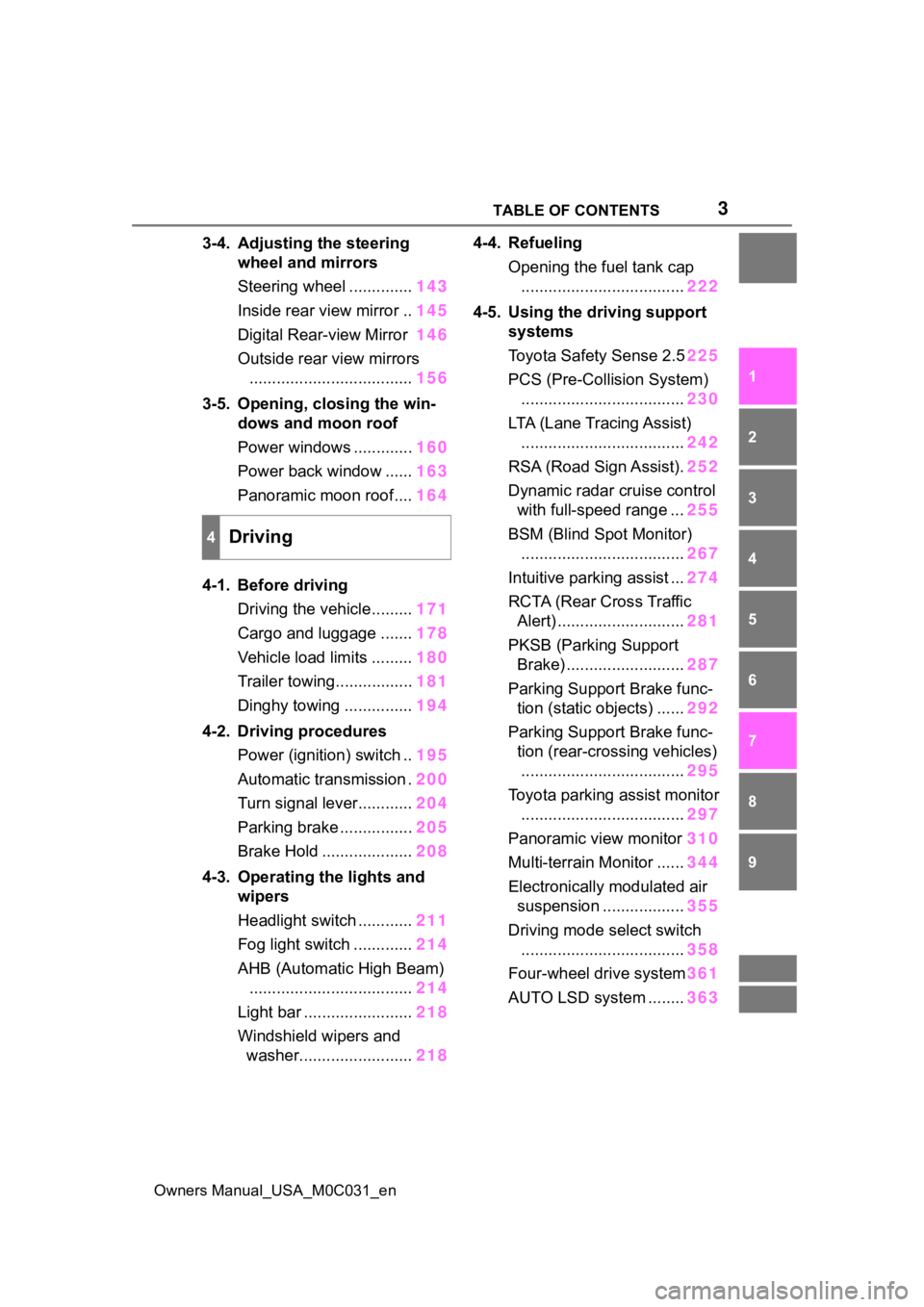
3TABLE OF CONTENTS
Owners Manual_USA_M0C031_en
1
2
3
4
5
6
7
8
9
3-4. Adjusting the steering wheel and mirrors
Steering wheel .............. 143
Inside rear view mirror .. 145
Digital Rear-view Mirror 146
Outside rear view mirrors .................................... 156
3-5. Opening, closing the win- dows and moon roof
Power windows ............. 160
Power back window ...... 163
Panoramic moon roof.... 164
4-1. Before driving Driving the vehicle......... 171
Cargo and luggage ....... 178
Vehicle load limits ......... 180
Trailer towing................. 181
Dinghy towing ............... 194
4-2. Driving procedures Power (ignition) switch .. 195
Automatic transmission . 200
Turn signal lever............ 204
Parking brake ................ 205
Brake Hold .................... 208
4-3. Operating the lights and wipers
Headlight switch ............ 211
Fog light switch ............. 214
AHB (Automatic High Beam) .................................... 214
Light bar ........................ 218
Windshield wipers and washer......................... 2184-4. Refueling
Opening the fuel tank cap.................................... 222
4-5. Using the driving support systems
Toyota Safet y Sense 2.5225
PCS (Pre-Collision System) .................................... 230
LTA (Lane Tracing Assist) .................................... 242
RSA (Road Sign Assist). 252
Dynamic radar cruise control with full-speed range ... 255
BSM (Blind Spot Monitor) .................................... 267
Intuitive parking assist ... 274
RCTA (Rear Cross Traffic Alert) ............................ 281
PKSB (Parking Support Brake) .......................... 287
Parking Support Brake func- tion (static objects) ...... 292
Parking Support Brake func- tion (rear-crossing vehicles).................................... 295
Toyota parking assist monitor .................................... 297
Panoramic view monitor 310
Multi-terrain Monitor ...... 34
4
Electro n
ically modulated air
suspension .................. 355
Driving mode s elect switch
.................................... 358
Four-wheel drive system 361
AUTO LSD system ........ 363
4Driving
Page 18 of 618
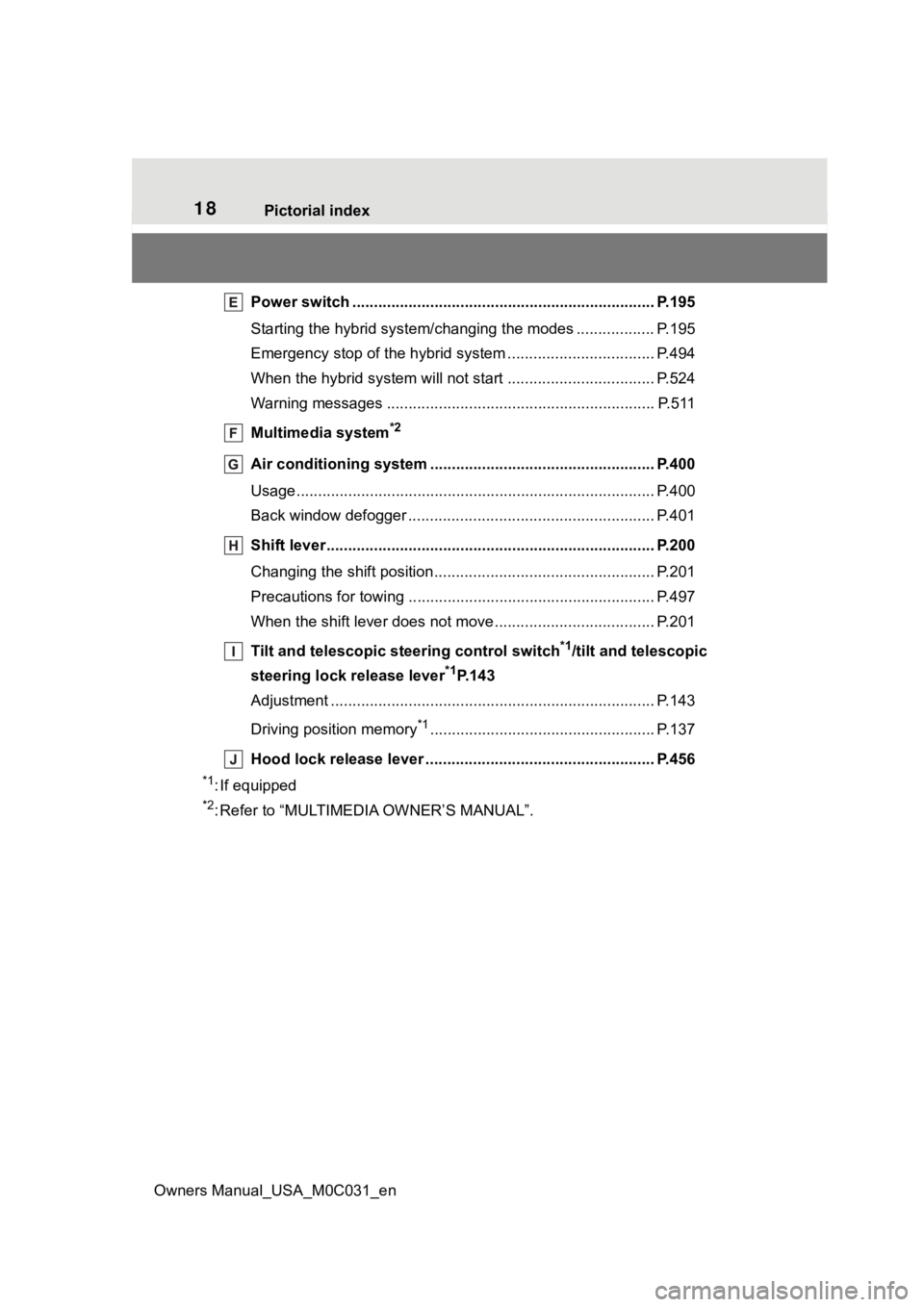
18Pictorial index
Owners Manual_USA_M0C031_en
Power switch ................................................... ................... P.195
Starting the hybrid system/changing the modes .................. P. 1 9 5
Emergency stop of the hybrid system ............................ ...... P.494
When the hybrid system will not start .......................... ........ P.524
Warning messages ............................................... ............... P.511
Multimedia system
*2
Air conditioning system ............................. ....................... P.400
Usage................................................................................... P.400
Back window defogger ........................................... .............. P.401
Shift lever.................................................... ........................ P.200
Changing the shift position.................................... ............... P.201
Precautions for towing .. ....................................... ................ P.497
When the shift lever does not move............................. ........ P.201
Tilt and telescopic st eering control switch
*1/tilt and telescopic
steering lock release lever
*1P.143
Adjustment ..................................................... ...................... P.143
Driving position memory
*1.................................................... P.137
Hood lock release lever ........................................ ............. P.456
*1: If equipped
*2: Refer to “MULTIMEDIA OWNER’S MANUAL”.
Page 32 of 618
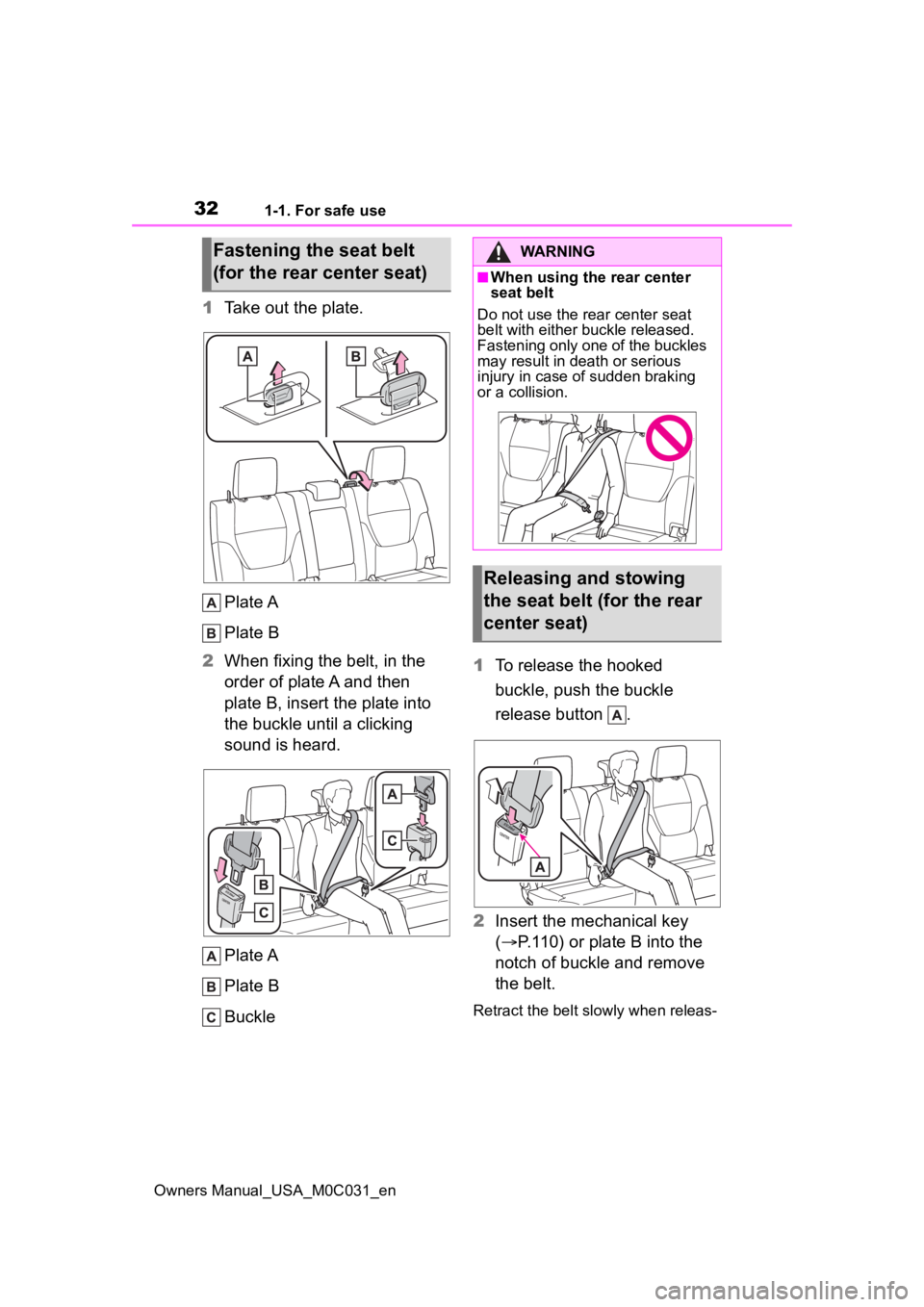
321-1. For safe use
Owners Manual_USA_M0C031_en
1Take out the plate.
Plate A
Plate B
2 When fixing the belt, in the
order of plate A and then
plate B, insert the plate into
the buckle until a clicking
sound is heard.
Plate A
Plate B
Buckle 1
To release the hooked
buckle, push the buckle
release button .
2 Insert the mechanical key
( P.110) or plate B into the
notch of buckle and remove
the belt.
Retract the belt slowly when releas-
Fastening the seat belt
(for the rear center seat)WARNING
■When using the rear center
seat belt
Do not use the r ear center seat
belt with either buckle released.
Fastening only one of the buckles
may result in death or serious
injury in case of sudden braking
or a collision.
Releasing and stowing
the seat belt (for the rear
center seat)
Page 33 of 618
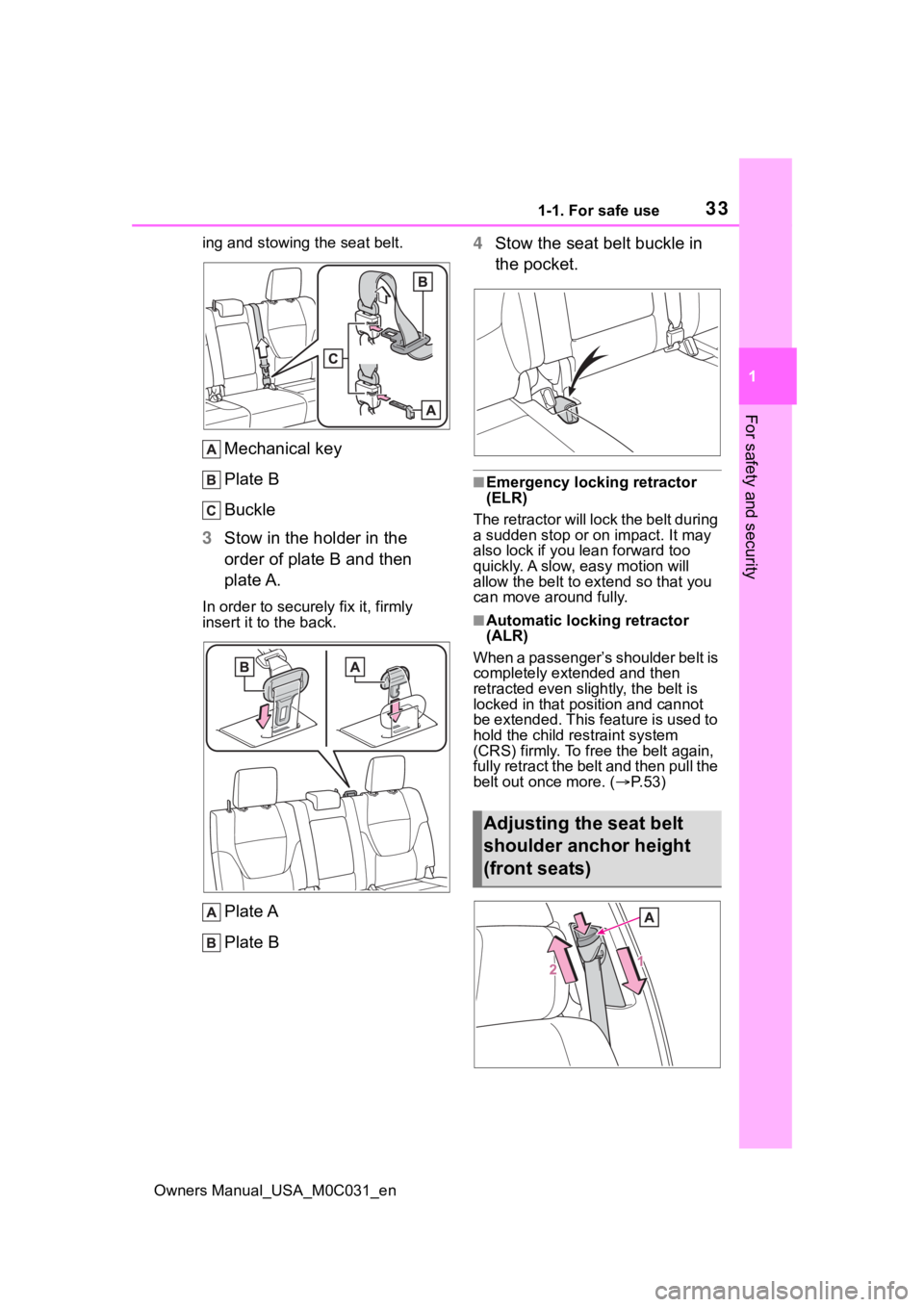
331-1. For safe use
Owners Manual_USA_M0C031_en
1
For safety and security
ing and stowing the seat belt.
Mechanical key
Plate B
Buckle
3 Stow in the holder in the
order of plate B and then
plate A.
In order to securely fix it, firmly
insert it to the back.
Plate A
Plate B 4
Stow the seat belt buckle in
the pocket.
■Emergency locking retractor
(ELR)
The retractor will lock the belt during
a sudden stop or on impact. It may
also lock if you lean forward too
quickly. A slow, easy motion will
allow the belt to extend so that you
can move around fully.
■Automatic locking retractor
(ALR)
When a passenger’s shoulder belt is
completely extended and then
retracted even slightly, the belt is
locked in that position and cannot
be extended. This feature is used to
hold the child restraint system
(CRS) firmly. To free the belt again,
fully retract the belt and then pull the
belt out once more. ( P. 5 3 )
Adjusting the seat belt
shoulder anchor height
(front seats)
Page 66 of 618
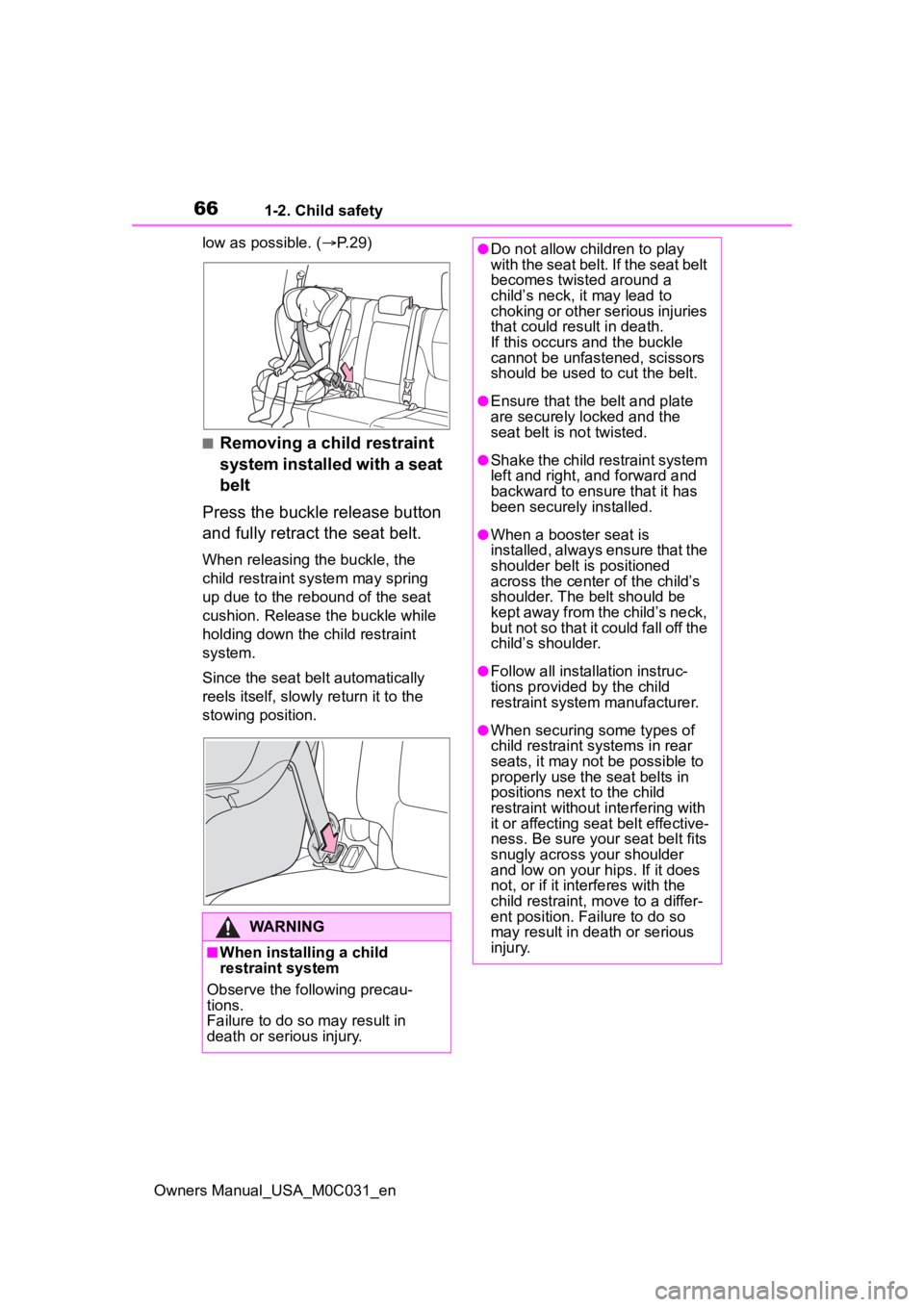
661-2. Child safety
Owners Manual_USA_M0C031_enlow as possible. (
P.29)
■Removing a child restraint
system installed with a seat
belt
Press the buckle release button
and fully retract the seat belt.
When releasing the buckle, the
child restraint system may spring
up due to the rebound of the seat
cushion. Release the buckle while
holding down the child restraint
system.
Since the seat belt automatically
reels itself, slowly return it to the
stowing position.
WARNING
■When installing a child
restraint system
Observe the following precau-
tions.
Failure to do so m ay result in
death or serious injury.
●Do not allow children to play
with the seat belt. If the seat belt
becomes twisted around a
child’s neck, it may lead to
choking or other serious injuries
that could result in death.
If this occurs and the buckle
cannot be unfastened, scissors
should be used to cut the belt.
●Ensure that the belt and plate
are securely locked and the
seat belt is not twisted.
●Shake the child restraint system
left and right, and forward and
backward to ensure that it has
been securely installed.
●When a booster seat is
installed, always ensure that the
shoulder belt is positioned
across the center of the child’s
shoulder. The belt should be
kept away from the child’s neck,
but not so that it could fall off the
child’s shoulder.
●Follow all installation instruc-
tions provided by the child
restraint system manufacturer.
●When securing some types of
child restraint systems in rear
seats, it may not be possible to
properly use the seat belts in
positions next to the child
restraint without interfering with
it or affecting seat belt effective-
ness. Be sure your seat belt fits
snugly across your shoulder
and low on your hips. If it does
not, or if it interferes with the
child restraint, move to a differ-
ent position. Fa ilure to do so
may result in death or serious
injury.
Page 71 of 618
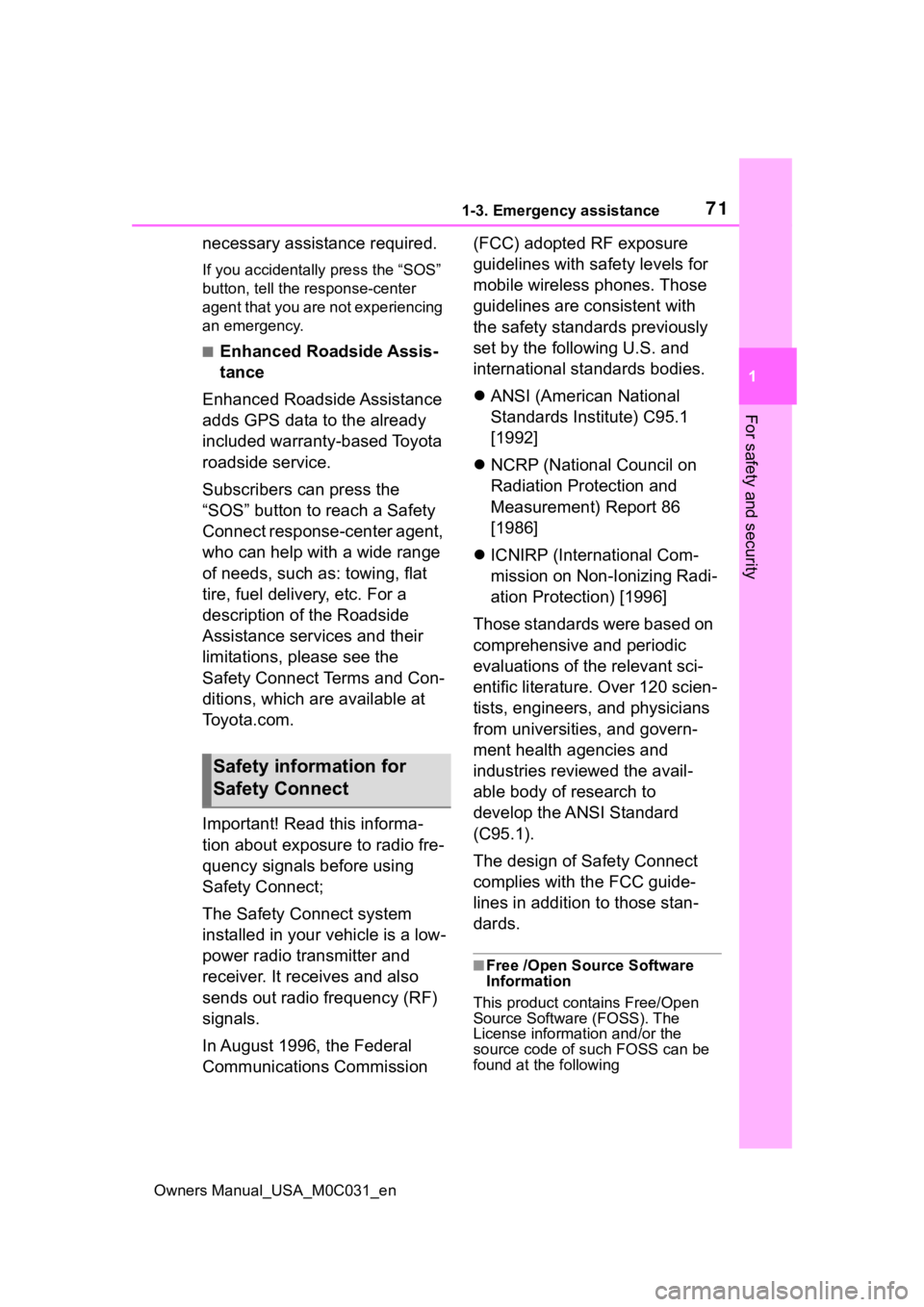
711-3. Emergency assistance
Owners Manual_USA_M0C031_en
1
For safety and security
necessary assistance required.
If you accidentally press the “SOS”
button, tell the response-center
agent that you are not experiencing
an emergency.
■Enhanced Roadside Assis-
tance
Enhanced Roadside Assistance
adds GPS data to the already
included warranty-based Toyota
roadside service.
Subscribers can press the
“SOS” button to reach a Safety
Connect response-center agent,
who can help with a wide range
of needs, such as: towing, flat
tire, fuel delivery, etc. For a
description of the Roadside
Assistance services and their
limitations, please see the
Safety Connect Terms and Con-
ditions, which are available at
Toyota.com.
Important! Read this informa-
tion about exposure to radio fre-
quency signals before using
Safety Connect;
The Safety Connect system
installed in your vehicle is a low-
power radio transmitter and
receiver. It receives and also
sends out radio frequency (RF)
signals.
In August 1996, the Federal
Communications Commission (FCC) adopted RF exposure
guidelines with safety levels for
mobile wireless phones. Those
guidelines are consistent with
the safety standards previously
set by the following U.S. and
international standards bodies.
ANSI (American National
Standards Institute) C95.1
[1992]
NCRP (National Council on
Radiation Protection and
Measurement) Report 86
[1986]
ICNIRP (International Com-
mission on Non-Ionizing Radi-
ation Protection) [1996]
Those standards were based on
comprehensive and periodic
evaluations of the relevant sci-
entific literature. Over 120 scien-
tists, engineers, and physicians
from universities, and govern-
ment health agencies and
industries reviewed the avail-
able body of research to
develop the ANSI Standard
(C95.1).
The design of Safety Connect
complies with the FCC guide-
lines in addition to those stan-
dards.
■Free /Open Source Software
Information
This product contains Free/Open
Source Software (FOSS). The
License information and/or the
source code of such FOSS can be
found at the following
Safety information for
Safety Connect
Page 78 of 618
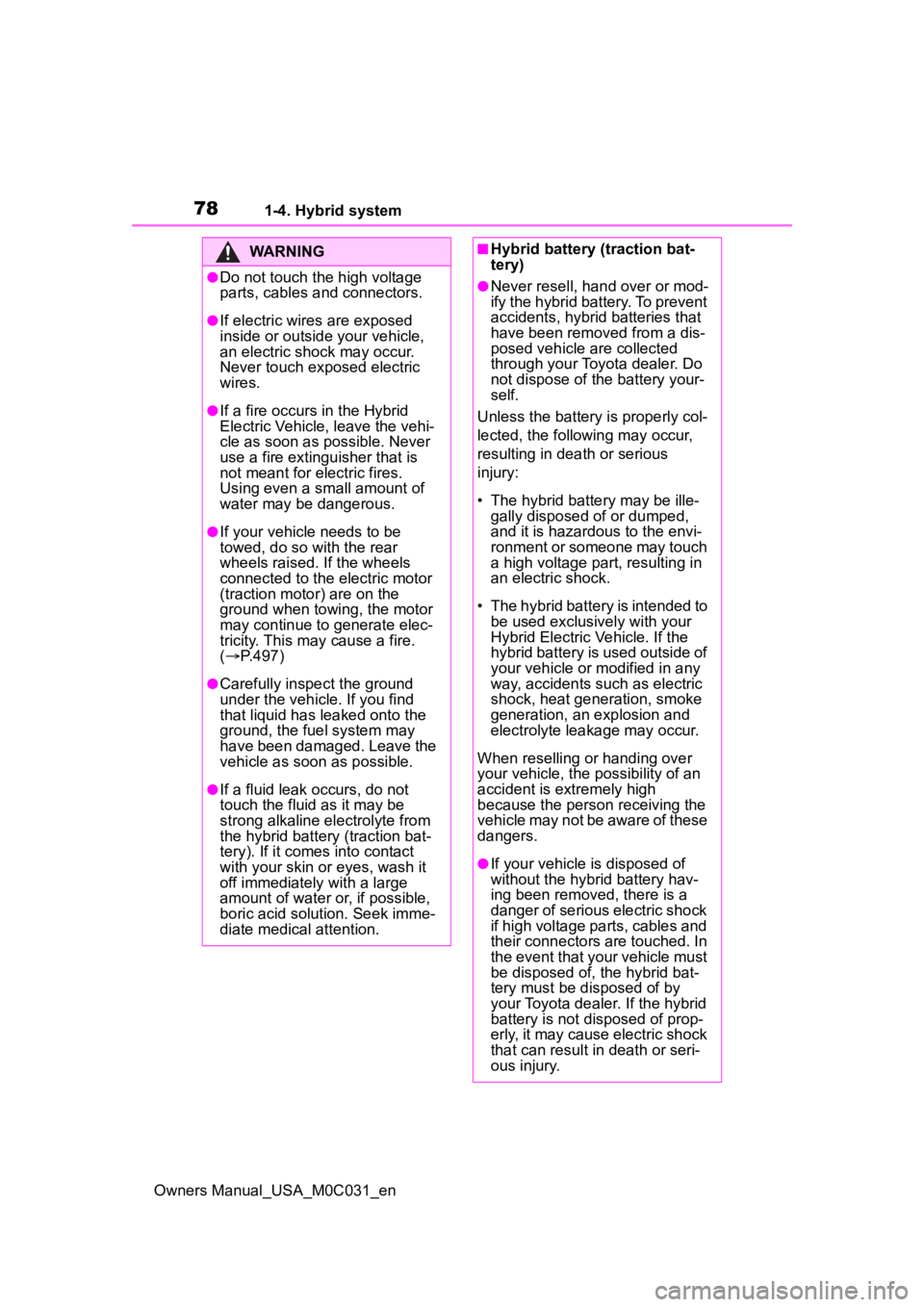
781-4. Hybrid system
Owners Manual_USA_M0C031_en
WARNING
●Do not touch the high voltage
parts, cables and connectors.
●If electric wires are exposed
inside or outside your vehicle,
an electric shock may occur.
Never touch exposed electric
wires.
●If a fire occurs in the Hybrid
Electric Vehicle, leave the vehi-
cle as soon as possible. Never
use a fire extinguisher that is
not meant for electric fires.
Using even a small amount of
water may be dangerous.
●If your vehicle needs to be
towed, do so with the rear
wheels raised. If the wheels
connected to the electric motor
(traction motor) are on the
ground when towing, the motor
may continue to generate elec-
tricity. This may cause a fire.
( P.497)
●Carefully inspect the ground
under the vehicle. If you find
that liquid has leaked onto the
ground, the fuel system may
have been damaged. Leave the
vehicle as soon as possible.
●If a fluid leak occurs, do not
touch the fluid as it may be
strong alkaline electrolyte from
the hybrid battery (traction bat-
tery). If it comes into contact
with your skin or eyes, wash it
off immediately with a large
amount of water or, if possible,
boric acid solution. Seek imme-
diate medical attention.
■Hybrid battery (traction bat-
tery)
●Never resell, hand over or mod-
ify the hybrid battery. To prevent
accidents, hybrid batteries that
have been removed from a dis-
posed vehicle are collected
through your Toyota dealer. Do
not dispose of the battery your-
self.
Unless the battery is properly col-
lected, the following may occur,
resulting in dea th or serious
injury:
• The hybrid batte ry may be ille-
gally disposed of or dumped,
and it is hazardous to the envi-
ronment or someone may touch
a high voltage part, resulting in
an electric shock.
• The hybrid battery is intended to be used exclusively with your
Hybrid Electric Vehicle. If the
hybrid battery is used outside of
your vehicle or modified in any
way, accidents such as electric
shock, heat generation, smoke
generation, an explosion and
electrolyte leakage may occur.
When reselling or handing over
your vehicle, the possibility of an
accident is extremely high
because the person receiving the
vehicle may not be aware of these
dangers.
●If your vehicle is disposed of
without the hybrid battery hav-
ing been removed, there is a
danger of serious electric shock
if high voltage parts, cables and
their connectors are touched. In
the event that your vehicle must
be disposed of, the hybrid bat-
tery must be disposed of by
your Toyota dealer. If the hybrid
battery is not disposed of prop-
erly, it may cause electric shock
that can result in death or seri-
ous injury.
Page 117 of 618
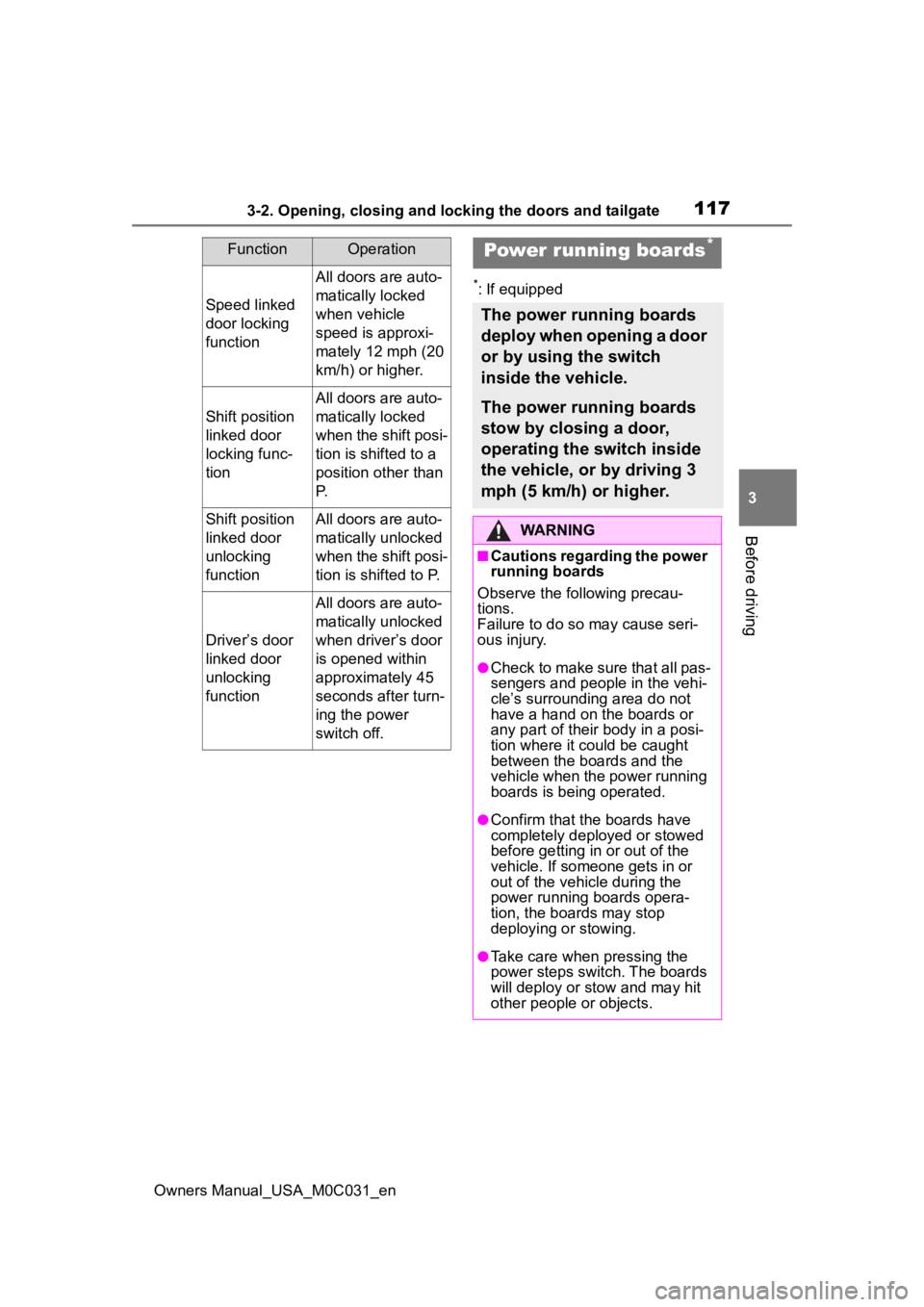
1173-2. Opening, closing and locking the doors and tailgate
Owners Manual_USA_M0C031_en
3
Before driving
*: If equipped
FunctionOperation
Speed linked
door locking
function
All doors are auto-
matically locked
when vehicle
speed is approxi-
mately 12 mph (20
km/h) or higher.
Shift position
linked door
locking func-
tion
All doors are auto-
matically locked
when the shift posi-
tion is shifted to a
position other than
P.
Shift position
linked door
unlocking
functionAll doors are auto-
matically unlocked
when the shift posi-
tion is shifted to P.
Driver’s door
linked door
unlocking
function
All doors are auto-
matically unlocked
when driver’s door
is opened within
approximately 45
seconds after turn-
ing the power
switch off.
Power running boards*
The power running boards
deploy when opening a door
or by using the switch
inside the vehicle.
The power running boards
stow by closing a door,
operating the switch inside
the vehicle, or by driving 3
mph (5 km/h) or higher.
WARNING
■Cautions regarding the power
running boards
Observe the following precau-
tions.
Failure to do so may cause seri-
ous injury.
●Check to make sure that all pas-
sengers and people in the vehi-
cle’s surrounding area do not
have a hand on the boards or
any part of their body in a posi-
tion where it could be caught
between the boards and the
vehicle when the power running
boards is being operated.
●Confirm that the boards have
completely deployed or stowed
before getting in or out of the
vehicle. If someone gets in or
out of the vehicle during the
power running boards opera-
tion, the boards may stop
deploying or stowing.
●Take care when pressing the
power steps switch. The boards
will deploy or stow and may hit
other people or objects.
Page 118 of 618
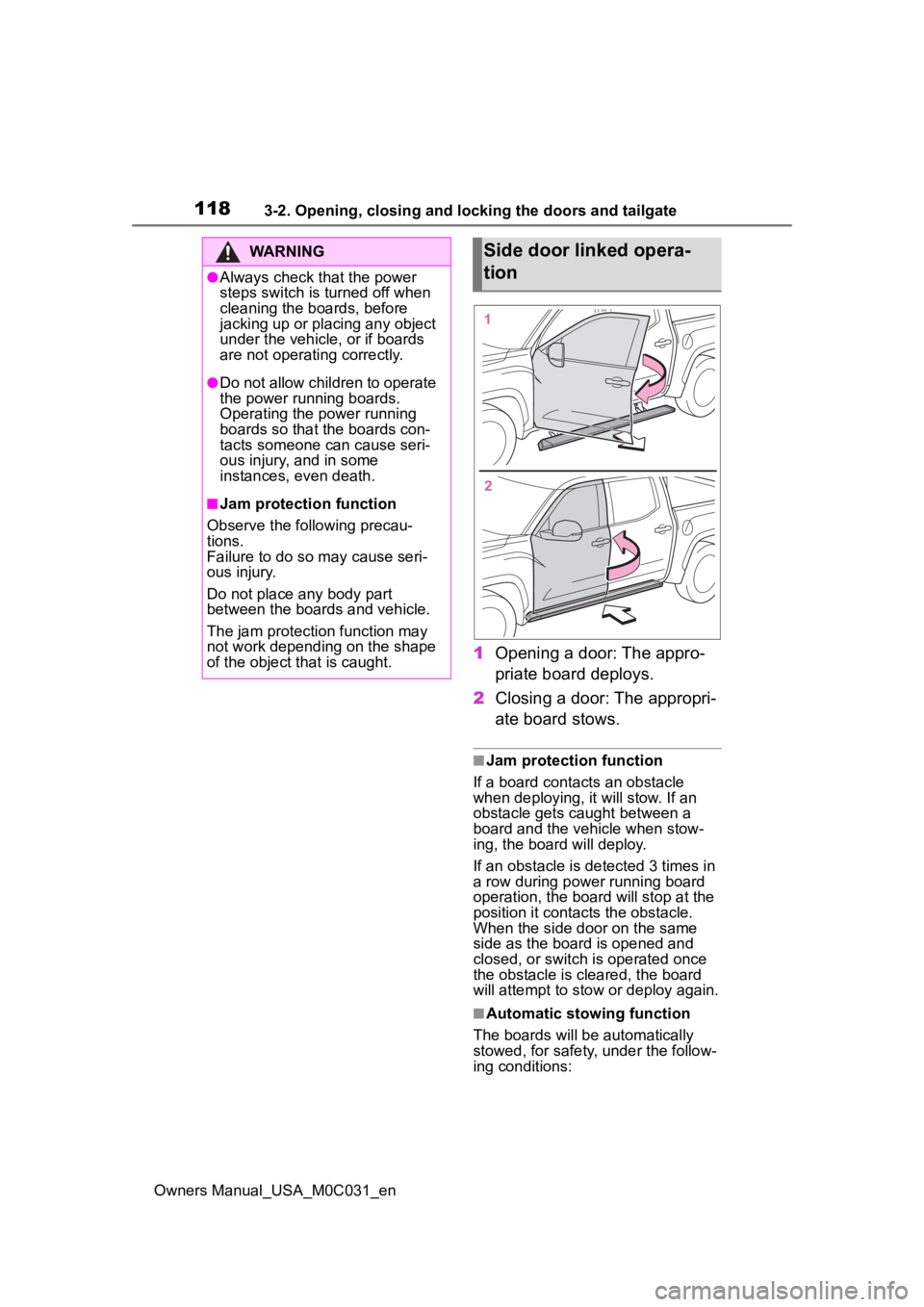
1183-2. Opening, closing and locking the doors and tailgate
Owners Manual_USA_M0C031_en
1Opening a door: The appro-
priate board deploys.
2 Closing a door: The appropri-
ate board stows.
■Jam protection function
If a board contacts an obstacle
when deploying, it will stow. If an
obstacle gets caught between a
board and the vehicle when stow-
ing, the board will deploy.
If an obstacle is de tected 3 times in
a row during power running board
operation, the boar d will stop at the
position it contacts the obstacle.
When the side door on the same
side as the board is opened and
closed, or switch is operated once
the obstacle is cl eared, the board
will attempt to stow o r deploy again.
■Automatic stowing function
The boards will be automatically
stowed, for safety, under the follow-
ing conditions:
WARNING
●Always check that the power
steps switch is turned off when
cleaning the boards, before
jacking up or placing any object
under the vehicle, or if boards
are not operating correctly.
●Do not allow children to operate
the power running boards.
Operating the power running
boards so that the boards con-
tacts someone can cause seri-
ous injury, and in some
instances, even death.
■Jam protection function
Observe the following precau-
tions.
Failure to do so m ay cause seri-
ous injury.
Do not place any body part
between the boards and vehicle.
The jam protection function may
not work depending on the shape
of the object that is caught.
Side door linked opera-
tion
Page 119 of 618

1193-2. Opening, closing and locking the doors and tailgate
Owners Manual_USA_M0C031_en
3
Before driving
●A board is not completely stowed
●Vehicle speed is approximately 3
mph (5 km/h) or higher
The boards will not automatically
deploy again when vehicle speed
returns to less th an 3 mph (5 km/h).
■If “Running Board Unable to
Deploy” is displayed on the
multi-Information display
The board may not be completely
deployed.
Close and open the door once more
or use the switch inside the vehicle
( P.119) and completely deploy the
board.
■If “Power Steps Unable to
Retract” is displayed on the
multi-Information display
The boards may not be completely
stowed.
Check that nothing is caught
between the boards and the vehicle.
■If “Power Steps System Mal-
function See Owner’s Manual”
is displayed on the multi-infor-
mation display
The system may be malfunctioning.
Have the vehicle inspected by Toy-
ota dealer.
■When snow or mud is attached
to the boards or the boards are
frozen
The power running boards may not
operate correctly. Before stepping
on a board, check that it is com-
pletely deployed. If the power run-
ning boards are not operating
correctly, turn the power steps
switch off and refrain from use.
■After recharging/reconnecting
the 12-volt battery
If the power running boards have
not completely deployed or stowed,
the boards may not move in the
intended direction the first time they
are operated. However, from the
second time onwards, the boards
will resume nor mal operation.
■When getting in and out of the
vehicle
Take care because clothes and
shoes may become dirty due to con-
tact with the lower part of the vehicle
body.
1 Deploys the running boards
on both sides.
2 Stows the running boards on
both sides.
The power bed step is also linked
with switch operations. ( P.126)
Putting the switch in the neutral
position sets the power running
boards to AUTO mode. AUTO
mode allows the deploying/stowing
of the boards to b e linked to open-
ing/closing of the side doors.
Both power running boards and
power bed step are deployed when
“OUT” position is selected. Opera-
tion only if steps are not already
deployed.
Both power running boards and
power bed step are stowed when
“OFF” position is s elected. Opera-
tion only if steps are not already
stowed.
Deploying and stowing
the power running boards
from inside